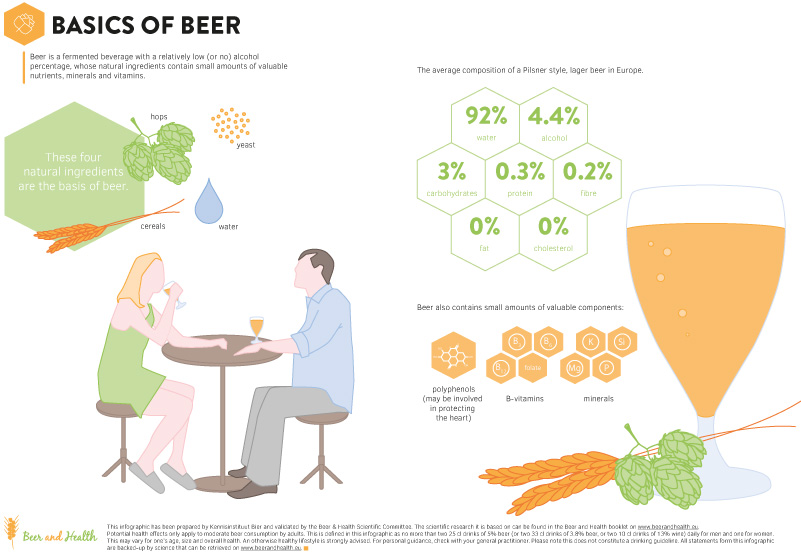
Key messages
- Beer is made of natural ingredients: water, cereals, hops and yeast.
- Thanks to these natural ingredients, beer can make a positive contribution to the diet, especially by providing B vitamins, minerals, polyphenols and fibre.
- By eating a balanced diet, most people obtain enough nutrients from food without consuming beer.
- If you drink beer, keep in mind that you should drink in moderation as part of a balanced diet.
What is in a beer?
In addition to the positive effects of moderate alcohol consumption (see Chapters 5, 6, 8 and 9), beer can also make a small contribution to diets by providing certain B vitamins, minerals, polyphenols and fibre. The actual composition of different beers range considerably depending on the raw materials used and the way it is made. Table 2 shows the average composition of regular pilsner/lager beers relative to recommended daily dietary intakes, and the nutritional highlights are discussed in this chapter. Gluten, which people having celiac disease have to avoid, will also be discussed. By eating a balanced diet, most people will get enough nutrients, though beer can also play a role in a balanced diet as long as it is consumed in moderation.
| Table 2. The Average composition of regular pilsner/lager beer in Europe relative to recommended dietary intakes | ||||
|---|---|---|---|---|
| Component | Unit | Average in beer Per 100 ml |
Daily requirements for adults (19–50 years old)14-16 |
|
| Men | Women | |||
| Water | g | 93 | 3700 | 2700 |
| Alcohol | % | 4.4 | – | – |
| Carbohydrate | g | 2.9 | 130 | 130 |
| Protein | g | 0.34 | 56 | 46 |
| Energy | kcal | 39 | 2550 | 1940 |
| Fibre | g | 0.2 | 38 | 25 |
| Vitamins | ||||
| Thiamin B1 | mg | 0.01 | 1.0 | 0.8 |
| Riboflavin B2 | mg | 0.03 | 1.3 | 1.1 |
| Niacin B3 | mg | 0.65 | 17 | 13 |
| Pantothenic acid B5 | mg | 0.06 | 5 | 5 |
| Pyridoxine B6 | mg | 0.04 | 1.4 | 1.2 |
| Folate | µg | 5.25 | 200 | 200 |
| Cobalamin B12 | µg | 0.05 | 1.5 | 1.5 |
| Minerals | ||||
| Calcium | mg | 4.90 | 700 | 700 |
| Copper | mg | 0.01 | 1.2 | 1.2 |
| Iron | mg | 0.09 | 8.7 | 14.8 |
| Potassium | mg | 35.33 | 3500 | 3500 |
| Magnesium | mg | 7.54 | 300 | 270 |
| Manganese | mg | 0.02 | 3 | 3 |
| Silicon13 | mg | 1.92 | ND | ND |
| Sodium | mg | 4.51 | 1600 | 1600 |
| Phosphorus | mg | 19.42 | 550 | 550 |
| Selenium | µg | 0.31 | 75 | 60 |
| Zinc | mg | 0.03 | 9.4 | 6.8 |
ND = not determined
Sources:
Composition of beer: Derived from the Food composition data of 16 European countries via www.EuroFIR.org (except for data on fibre and silicon).
Dietary recommendations: European Food Safety Authority,14British Nutrition Foundation,15 Food and Nutrition Board16
Vitamins
Small quantities of many B vitamins are available in beer, and their bioavailability has been confirmed by intervention research that has shown an increased absorption level of B vitamins with moderate beer consumption (330 ml per day for women and 660 ml per day for men).17,18
Folate and homocysteine levels
An experimental and a population study have demonstrated that beer consumption may help to maintain homocysteine levels in the normal range due to the high folate content,17,19 whereas wine, vodka and whiskey contain no detectable levels of folate.20 High homocysteine levels are found in people having cardiovascular or Alzheimer’s disease, though meta-analyses show that lowering homocysteine levels by using B vitamins did not have a significant effect on cardiovascular events, cognitive aging or mortality.21,22
Minerals
Cereals, water, hops, yeast and processing conditions can all contribute to the mineral content of beer23. About 75% of the minerals in beer come from the malt, with the remaining 25% originating from the water.24 Some important minerals for health effects include silicon, potassium and sodium.
Silicon
Many biological roles of silicon remain unknown, and consequently, the recommended daily silicon intake has not yet been set.25 Beer is a substantial source of silicon in the diet, in the range of 6.4–56.5 mg/l26 with an average of ~19 mg/l. After drinking beer, serum and urinary silicon levels increase significantly, confirming that beer is a readily bioavailable source of silicon,27 and beers made from barley tend to contain more silicon than those made from wheat. Hops contain substantially more silicon than cereals, but quantitatively, hops make a much smaller contribution to beer than cereals. In comparison, wines and spirits have lower levels of silicon.13 A review shows that the accumulated evidence over the past 30 years indicates that silicon plays an important role in bone formation and in bone and connective tissue health,13 and it is suggested that the silicon component of beer may contribute to some of these positive effects.28 However, more research is needed to investigate whether the dietary silicon provided by moderate beer consumption actually reduces the risks of developing osteoporosis (see Chapter 9).
Potassium to sodium ratio
Beer has a relatively high potassium to sodium ratio (typically 4:1), which is beneficial in keeping blood pressure at normal and healthy levels.29
Polyphenols
In the past decade, there has been increased interest in the potential health benefits of dietary plant polyphenols, due to their observed antioxidant and anti-inflammatory effects. Epidemiological studies and associated meta-analyses suggest that the long term consumption of diets rich in plant polyphenols offer protection against the development of cancers, cardiovascular diseases, diabetes, osteoporosis and neurodegenerative diseases.30
Polyphenols in beer
More than 35 phenolic compounds have been identified in beer, with about 80–90% from the malt and 10–20% from the hops.23 The total amount of polyphenols depends on the type of beer, based on the raw materials and the brewing process. Per drink (of equivalent alcohol content), beer contains more than twice as many polyphenols as white wine and half the amount in red wine.31 In beer, xanthohumol and its metabolites isoxanthohumol and phytoestrogen 8-prenylnaringenin provide in vitro health properties such as anticarcinogenic, anti-invasive, anti-inflammatory and antioxidant effects. However, further studies in humans are needed to determine whether the plasma concentrations of such compounds derived from moderate beer consumption have the same bioactivity as observed in vitro.32
Cardiovascular disease and polyphenols
As can be seen in Chapter 5, the consumption of 10–20 g alcohol per day can have protective effects against cardiovascular disease. Different studies speculate that other factors in beer (and wine) could also be protective; mainly polyphenols,32,33 and two studies suggest polyphenols in non-alcoholic beer may also play a part (see Chapter 4). More randomized clinical trials focused on identifying the actual mechanisms behind the action of polyphenols are needed to understand if and how much they contribute to the protective effect.
Fibre
Although international food composition tables report no dietary fibre in beer, it is evident that lager and dark beers do contain amounts of soluble dietary fibre (1.87–2.02 g/l). Soluble fibre in beer is derived from the cell walls of barley, and the indigestible carbohydrates (ß-glucans and arabinoxylans) are the largest constituents of dietary fibre.12 The European Food Safety Authority (EFSA) concluded that barley ß-glucans have been shown to lower blood cholesterol, and at least 3 g of barley ß-glucans should be consumed per day in order to obtain the claimed effect.34 Barley ß-glucans are often found in beer, however, the levels vary widely depending on brewing processes, and more research is necessary.
Gluten
In Europe, an estimated 1% of adults and children have celiac disease, an autoimmune disorder in which the immune system reacts to gluten.35 As beer is usually made from malted barley or wheat, it will therefore contain small quantities of gluten. There is an issue however, regarding the determination of gluten levels in beer, as the current method described by the Codex Alimentarius is not valid for use in hydrolyzed and fermented products.36 For people diagnosed with celiac disease, only beer with the official gluten free logo should be consumed . Official gluten-free beers are brewed by using techniques that reduce the level of gluten in barley-based beer, use gluten free cereals, or use fermentable sugars or syrups.38
Remember: It is better to drink alcoholic beverages on a full stomach
If alcohol is consumed on an empty stomach, it is absorbed faster than if the stomach is full. Since elimination of alcohol does not depend on factors that can be directly influenced, peak blood alcohol concentration (BAC) when drinking alcoholic beverages on an empty stomach will be higher than when drinking during or soon after having a meal.39 But the type of alcoholic beverage is also important. When drinking on an empty stomach, more concentrated beverages like spirits will produce a higher peak BAC than when the same amount of alcohol is consumed as beer. When alcohol is consumed with or soon after a meal, the highest peak BAC is seen with more diluted drinks like beer, but this peak is still lower than when drinking beer on an empty stomach.40 So to avoid high peak blood alcohol concentrations, it is better to drink alcoholic beverages with or soon after a meal, or to choose more diluted beverages like beer.
Prof Frans Kok
 Emeritus Professor of Nutrition and Health, Wageningen University, the Netherlands
Emeritus Professor of Nutrition and Health, Wageningen University, the Netherlands
Expertise: Diet in disease prevention, energy balance and body composition
How does moderate beer consumption fit in a healthy lifestyle?
“First of all, there is an obvious risk of medical and social harm from alcohol abuse. And you don’t have to drink alcoholic beverages for your health. There are many other ways to stay healthy. Adults who are used to drinking alcoholic beverages are advised to limit their intake to a maximum of two drinks per day for men and a maximum of one drink for women. The most favourable drinking pattern is regular daily or almost daily drinking, while avoiding the clearly harmful binge drinking. Keeping this in mind, beer consumption can be part of a healthy lifestyle.”
If beer is consumed in moderation, how does it affect your health?
“Adults, who limit their beer consumption to one or two drinks per day, benefit from a lower risk of cardiovascular disease, type 2 diabetes and dementia. Furthermore, beer is made only from natural ingredients, in which there are small amounts of B vitamins from the cereal and yeast, and fibre and polyphenols from the cereals and hops which might also have beneficial effects, but further research is needed. And remember that by eating a balanced diet, most people will get enough nutrients from their food.”
What would you like to study in the area of moderate beer consumption as part of a healthy lifestyle, if you had unlimited funds?
“There are non-alcoholic, low-alcoholic and alcoholic beers. It would be interesting to see whether and how these beverages differ in their influence, for example on rehydration. With increasing life expectancy and the increasing number of elderly people, hydration is an important topic.”







